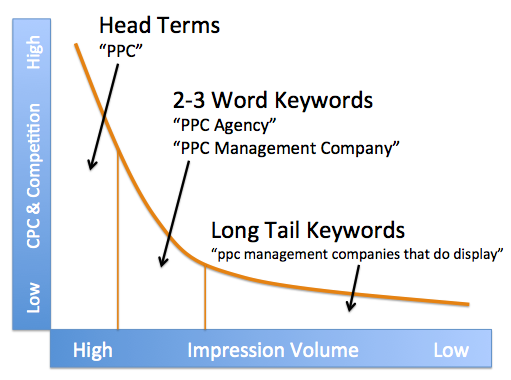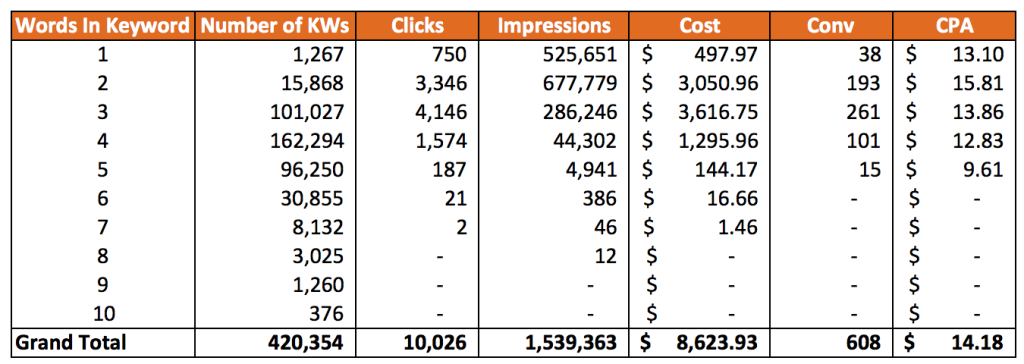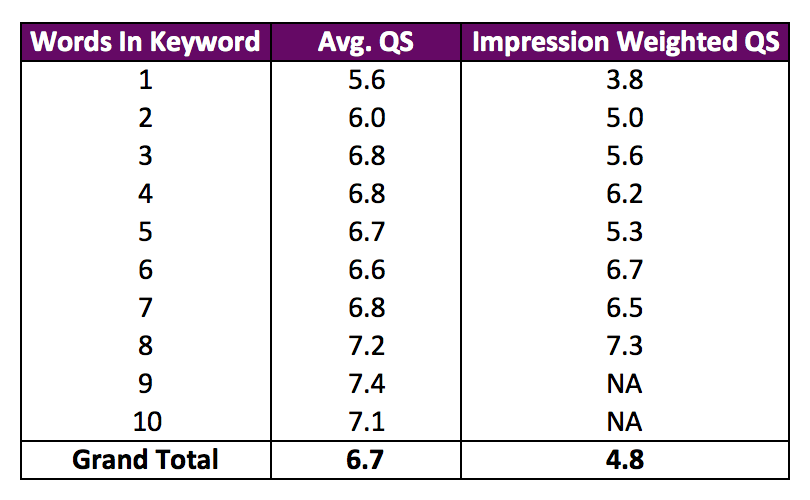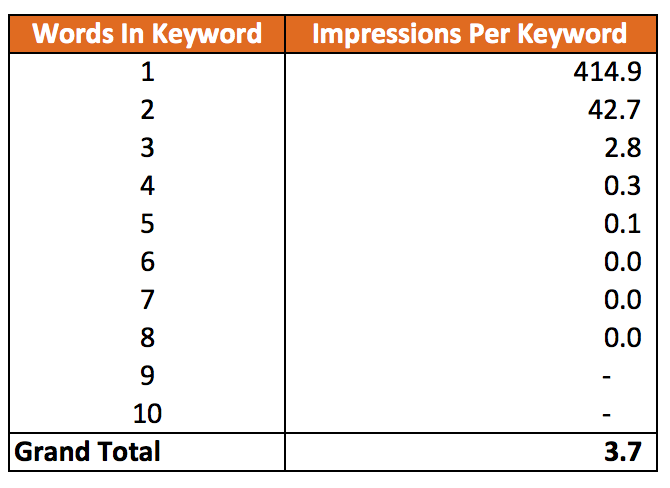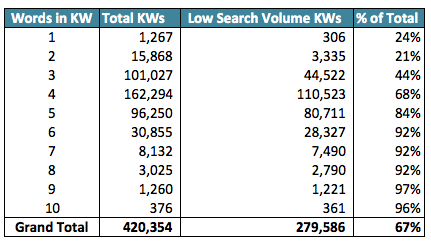One of the trickiest decisions in building out new campaigns in your account is how in depth you need to get with your keyword build out. On the one hand, building out every conceivable search term into its own exact match ad group seems like the best way to ensure maximum coverage. On the other hand, focusing your time and effort into making sure your head terms are well optimized and have great ads can have a big payoff.
Take a look at the example I put together in the chart below:
For this fictitious PPC agency, let’s call them “Manapin Harketing”, you can see that the vast majority of impressions are coming from shorter one or two word terms like “PPC”, “PPC Agency”, “PPC Management Company” and so on. However, the cost of bidding on these keywords is high, and there can be good value to be found in the longer search queries.
To find out how important long-tail search queries are for your account, go into the dimensions tab (or the show search terms tab) and use the Search Terms drop down. Download this data and then add a field in your spreadsheet for the number of words in each search query. I used the following formula to calculate the number of words.
This formula is counting the number of spaces by doing the number of characters with spaces included minus the number with spaces removed and then adding 1 as you normally have one more word than space in a keyword (Note: for modified broad you will need to use TRIM functionality to remove an initial space in front of your first “+” symbol when doing this with Keywords rather than search terms).
From here, pivot your data. I’m looking for Converted Clicks and CPA, the latter of which I had to use a calculated field to set up.
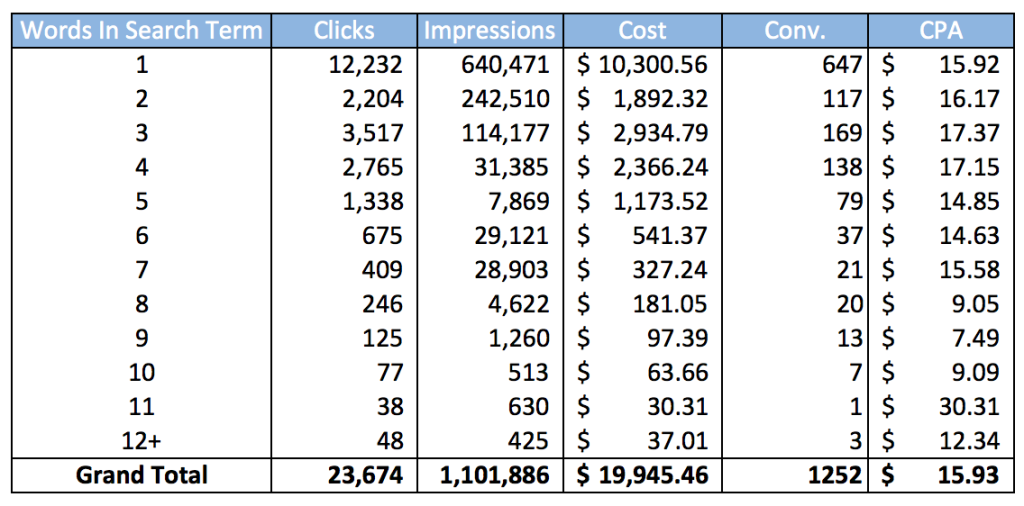
You can see that we get a not insignificant proportion (181 out of 1252) of our conversions from 5+ word search queries. The CPA is also pretty good in this case – $13.54 for long tail keywords vs. $16.33 for the shorter terms.
However, despite the fact that long tail search terms are clearly important in this account, the question becomes, would it be worth my time and effort to build out ad groups for all of these terms?
There are, to my mind, three reasons you would want to build out your very long tail keywords:
- Ad Copy Relevancy
- Greater control over bidding
- Long tail keywords work well for your account
It seems like best practices have always told us that we absolutely need to build out all these keywords to ensure the absolute best Quality Score by having super relevant ads and landing pages that generate high click-through rates. However, I have a major problem with this: Our ads simply don’t give us enough characters to write targeted ad copy once you approach five keywords. Therefore for a lot of my long tail keywords, I’m stuck using the exact same ads I have for my 3-4 word keywords. My ad for the keyword “ppc management company that does display advertising” is probably the exact same as for the keyword “ppc management for display”. There’s very little extra relevancy I can eek out without making a pretty terrible ad.
As for greater control over bidding, I also think this is overblown. I did a quick filter of the data above for search terms of 5 words or longer. The most clicks any individual term had was 7. That means I’m still having to aggregate my data to set bids anyway.
Finally, to see how well long-tail keywords work in your account, you’ll have to pull your own data. Let me show you some examples from the campaign above.
The table shows that CPA is actually pretty good for longer keywords, but that despite having tens of thousands of keywords with 6+ words in the keyword, they’ve generated zero conversions in the past couple of weeks.
As for click-through rates of my longer keywords, you can see that there’s a pretty sharp uptick as the search terms get longer. This makes sense given that shorter, broader keywords are likely to have an audience of people searching for more diverse things than your service/product, whereas I’d hope you were only targeting long keywords that are super specific to your business:
This also lines up pretty closely with what we’re seeing with our long-tail quality scores:
Notice that for both average and impression-weighted quality scores there is a noticeable improvement as our keywords get longer. Again, as above with CTRs this makes sense given these long tail keywords are much more likely to be specific to our business.
All of these reports are pretty simple to pull with a little pivot table magic. I’d recommend you try looking at how these long tail keywords are important in your own accounts as it varies a ton by industry. Try taking a look at this post by PPC Hero’s own Eric Couch last year for some more insights.
Overlapping Search Terms:
One report I love to run with my long-tail keywords is the “are my search terms triggering the right keywords” report. If you download your search terms report with “keyword” as one of the columns, you can use a pivot table that has “Search Term” and then “Keyword” in the row labels. Any search term with multiple keywords underneath it isn’t triggering where you want it to. Here’s an example from a golf resort account:
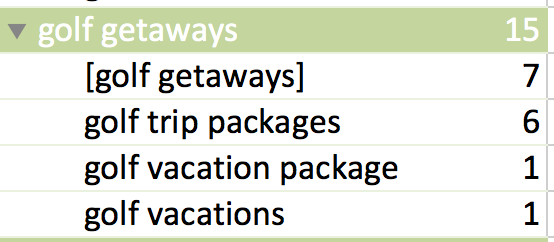
If your long-tail keywords are also having this problem it might mean that your fancy, long-winded build out was a waste of time anyway. You’ll want to use negatives to direct your search terms to the right keywords in this case. If you throw in a filter for your “Words in Keyword” data and only filter this by long tail keywords, it should be a pretty quick skim to check.
How Should You Set Up Your Account?
I’ve settled firmly in the camp of using modified broad match to sweep up the majority of my long tail traffic. I extremely rarely build out any keywords longer than 5 words long anymore. As you can see in the chart below, the amount of impressions my long tail keywords generate is minimal for the time invested:
I also took a look at the number of these keywords that simply get lumped in as “Low Search Volume.” Having a ton of these can really clutter your account:
Notice what a huge percentage of my keywords are simply Low Search Volume once I approach even 4 words in the keyword? I’ve essentially wasted 90+ percent of the time I spent building out super long-tail keywords.
With that in mind, my ideal campaign structure now looks like this:
- General Campaign A
- Top Performers Campaign A
- General Campaign B
- Top Performers Campaign B
In the General campaign go all of my keywords, with modified broad heavily used. Once a week I trawl the search term report from this General campaign and any search terms that have more than 2 conversions in their history get their own single keyword ad group (SKAG) in the “Top Performers” campaign. Remember to throw in the negative exact of your new Top Performer keyword back into the general campaign too. This means I can still pull in any long tail keywords that generate enough conversions to deserve their own unique bid, but without worrying about a mammoth build out operation.
The benefits of this are:
- It saves me a ton of time.
- I can keep an eye on my most important keywords.
- The bulk of my traffic lies in heavily optimized, highly relevant ad groups.
To summarize, long tail traffic will probably still be important to you – pull the pivot tables and see for your own account. However, building long-tail keywords into your account might not be adding the value you think it is. By using the “Top Performer” campaigns you can make sure any super important long-tail keywords are built out, without worrying about the ones that will generate so little traffic as to simply clutter your account.
What are your long-tail keyword preferences? Do you start broad and build out? Do you start with a monster Excel sheet and trim down later? As always, we’d love to hear from you in the comments below!




